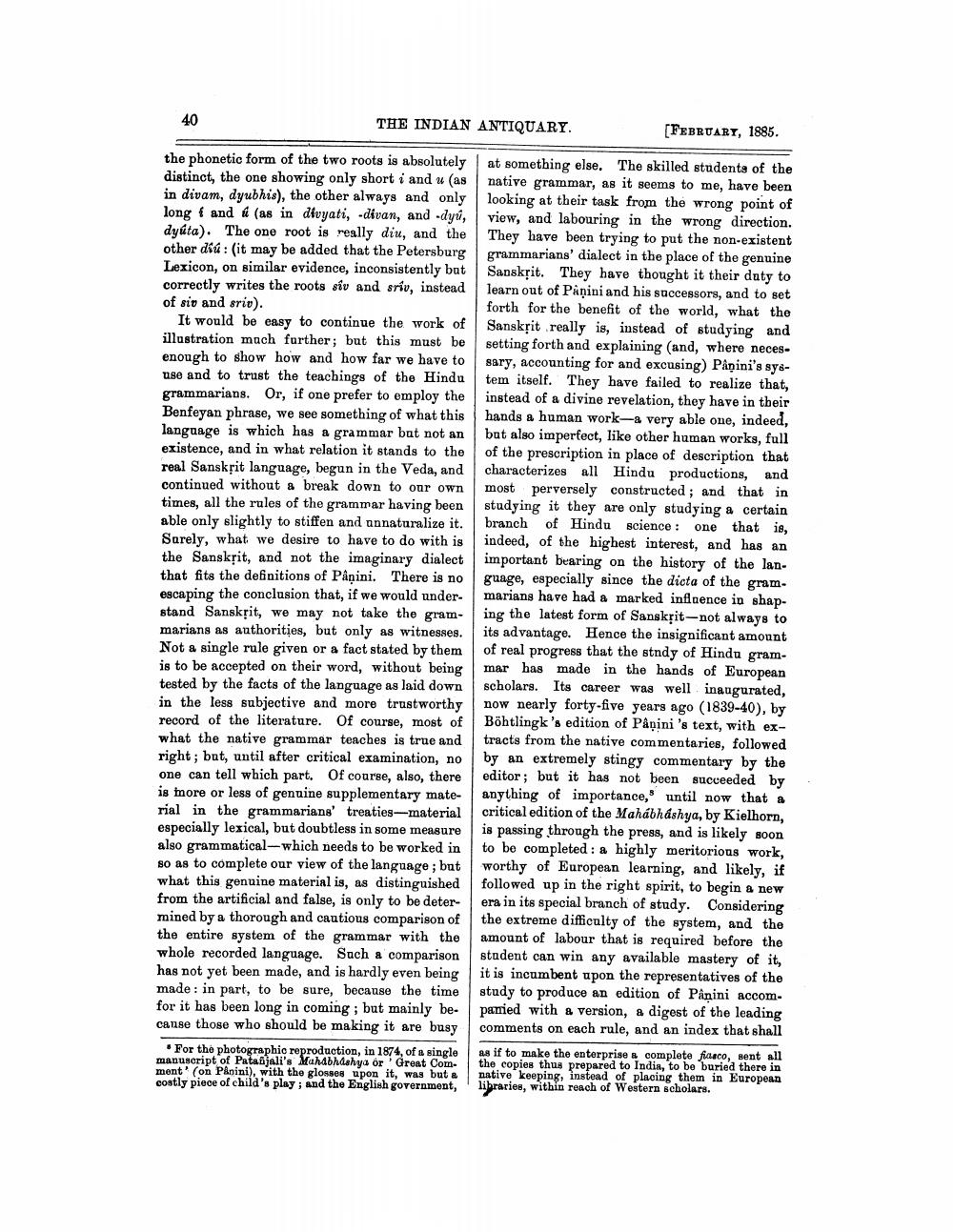________________
40
THE INDIAN ANTIQUARY.
[FEBRUARY, 1885.
the phonetic form of the two roots is absolutely distinct, the one showing only short i and u (as in divam, dyubhis), the other always and only long and ú (as in divyati, -divan, and dyú, dyúta). The one root is really diu, and the other diú : (it may be added that the Petersburg Lexicon, on similar evidence, inconsistently but correctly writes the roots sîv and sriv, instead of siv and sriv).
It would be easy to continue the work of illustration mach further; but this must be enough to show how and how far we have to use and to trust the teachings of the Hindu grammarians. Or, if one prefer to employ the Benfeyan phrase, we see something of what this language is which has a grammar but not an existence, and in what relation it stands to the real Sanskrit language, begun in the Veda, and continued without a break down to our own times, all the rules of the grammar having been able only slightly to stiffen and annaturalize it. Surely, what we desire to have to do with is the Sanskrit, and not the imaginary dialect that fits the definitions of Påņini. There is no escaping the conclusion that, if we would understand Sanskrit, we may not take the grammarians as authorities, but only as witnesses. Not a single rule given or a fact stated by them is to be accepted on their word, without being tested by the facts of the language as laid down in the less subjective and more trustworthy record of the literature. Of course, most of what the native grammar teaches is true and right; but, until after critical examination, no one can tell which part. Of course, also, there is more or less of genuine supplementary material in the grammarians' treaties-material especially lexical, but doubtless in some measure also grammatical-which needs to be worked in so as to complete our view of the language ; but what this genuine material is, as distinguished from the artificial and false, is only to be determined by a thorough and cautious comparison of the entire system of the grammar with the whole recorded language. Such a comparison has not yet been made, and is hardly even being made: in part, to be sure, because the time for it has been long in coming ; but mainly becanse those who should be making it are busy
For the photographic reproduction, in 1874, of a single manuscript of Pataijali's Mahabhashya or Great Com. ment' (on Panini), with the glosses upon it, was but a costly piece of child's play; and the English government,
at something else. The skilled students of the native grammar, as it seems to me, have been looking at their task from the wrong point of view, and labouring in the wrong direction. They have been trying to put the non-existent grammarians' dialect in the place of the genuine Sanskpit. They have thought it their duty to learn out of Paņini and his successors, and to set forth for the benefit of the world, what the Sanskrit really is, instead of studying and setting forth and explaining (and, where necessary, accounting for and excusing) Påņini's system itself. They have failed to realize that, instead of a divine revelation, they have in their hands a human work-a very able one, indeed, but also imperfect, like other human works, full of the prescription in place of description that characterizes all Hindu productions, and most perversely constructed; and that in studying it they are only studying a certain branch of Hindu science: one that is, indeed, of the highest interest, and has an important bearing on the history of the language, especially since the dicta of the gram. marians have had a marked influence in shaping the latest form of Sanskrit-not always to its advantage. Hence the insignificant amount of real progress that the stndy of Hindu grammar has made in the hands of European scholars. Its career was well inaugurated, now nearly forty-five years ago (1839-40), by Böhtlingk's edition of Pâņini's text, with extracts from the native commentaries, followed by an extremely stingy commentary by the editor; but it has not been succeeded by anything of importance, until now that a critical edition of the Mahábhashya, by Kielhorn, is passing through the press, and is likely soon to be completed : a highly meritorious work, worthy of European learning, and likely, if followed up in the right spirit, to begin & new era in its special branch of study. Considering the extreme difficulty of the system, and the amount of labour that is required before the student can win any available mastery of it, it is incumbent upon the representatives of the study to produce an edition of Panini accompanied with a version, a digest of the leading comments on each rule, and an index that shall
as if to make the enterprise & complete fiasco, sent all the copies thus prepared to India, to be buried there in native keeping, instead of placing them in European libraries, within reach of Western scholars.




